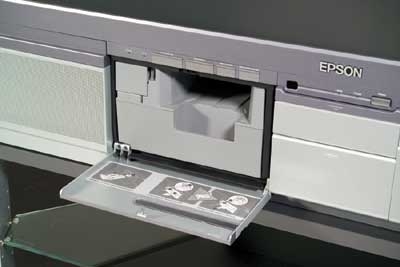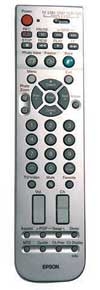Epson Livingstation 57-inch Rear-Projection LCD HDTV Page 2
SETUP After loading the printer with ink and paper and connecting my A/V gear, I installed the convenient speaker shelf (not shown), which allows a center speaker of up to 11 pounds to rest atop the TV. It's an excellent idea that I hope gets copied by other TV makers. 
Then I connected the external HDTV tuner (the larger box in the photo above), which includes a basic remote control. You also get a more elaborate remote (nonbacklit) for the TV itself. The tuner is a bare-bones model, but it performed well in our difficult urban testing environment, grabbing more digital stations than the one inside our Dish 921 satellite receiver.
The Epson offers few of the advanced picture tweaks found on some other HDTVs but did give a choice of three color-temperature presets - one of which proved very accurate (see "in the lab," at the end of this article). Epson claims a bulb life up to 10,000 hours, which far exceeds claims made by other microdisplay manufacturers. A replacement bulb costs $249.
 PHOTO FEATURES With everything up and running, I put the digital imaging features through their paces. Toward the top of the remote is the big blue Print button, alongside Photo View and Freeze. To print an onscreen image (from any channel or input except PC or DVI), you first freeze it, after which you are presented with three sequential images. I chose one, pressed Print, and about 2 minutes later the TV spat out a photo. The print quality was decent - sharp enough to read most photo credits - but considerably softer than the onscreen image. Also, one of two review samples I tried suffered from frequent paper jams, though the other worked perfectly every time.
PHOTO FEATURES With everything up and running, I put the digital imaging features through their paces. Toward the top of the remote is the big blue Print button, alongside Photo View and Freeze. To print an onscreen image (from any channel or input except PC or DVI), you first freeze it, after which you are presented with three sequential images. I chose one, pressed Print, and about 2 minutes later the TV spat out a photo. The print quality was decent - sharp enough to read most photo credits - but considerably softer than the onscreen image. Also, one of two review samples I tried suffered from frequent paper jams, though the other worked perfectly every time.
The Photo View button displays whatever JPEG images are on the card(s) or CD as thumbnails on the screen. I was able to enlarge and rotate the images and create a digital slideshow. I could also crop photos for printing to some extent by zooming in on certain sections. Overall, I found the system intuitive and easy to use but pretty basic.
PICTURE QUALITY Of course, I was most interested in seeing how the Epson stacked up as a TV. In eager anticipation of revisiting one of my favorite movies, I dropped the extended edition of The Lord of the Rings: The Return of the King into my player. This is one of the best-looking DVD movies ever, and I was impressed by the amount of detail that came through. As Theoden faces down Saruman at the tower of Isengard, I could see the weathered devices in the king's armor and clearly make out individual rings of chain mail in Eomer's armor. This level of sharpness, however, was only available with my DVD player in progressive-scan mode. When I changed its output to interlaced, the image softened considerably.
The TV had no problem rendering rich, natural colors. After turning up the color a bit, I was rewarded with lush greens in the initial pan over Fangorn's trees. Skin tones looked accurate too, with Merry and Pippin's faces appearing neither wan nor flushed.
The Epson can produce a very bright image. This is a boon for daylight viewing, but it also brings out the "screen-door" effect, where the pixel structure actually becomes visible. For example, when Ar-wen approaches the shards of the sword Narsil, a dramatic backlight in the center of the screen made a faint grid obvious at any distance within 8 feet of the screen. That may be a little close for a TV this size, though a series of almost-invisible vertical lines across the screen - another sign of pixel structure - was visible from even greater distances. It wasn't hugely distracting but was more apparent than on other comparable-size microdisplays I've reviewed.
The movie is packed with dark scenes too, and as I watched them I couldn't shake the feeling that they weren't dark enough. When a captivated Frodo gets drawn toward the front gate of Minas Morgul, the shadows in the fortress and along the road appeared too grayish, even compared with other LCD microdisplays I've seen.
|
Next I turned to HDTV from Time Warner's digital cable feed. As I was flipping through channels, I immediately noticed a pincushion effect with squarish 4:3 programs. The vertical edges were bowed in toward the middle and out toward the top and bottom, a glitch that also appeared in widescreen source material containing vertical lines, like Time Warner's onscreen program guide or scenes showing the edges of buildings or doorways.
This effect was fairly severe, not at all typical of microdisplays, and evident on both test samples I looked at. It was less noticeable when the image was expanded to fill the screen, which is only possible by using the external tuner's aspect ratio control. Epson says it will send a technician to your home to adjust the screen if your set has this problem and is still under warranty.
Pincushioning aside, high-def looked extremely good. I caught an episode of Urban Wild on Discovery HD Theater, and the detail made the shots of Paris come to life. I could almost see into the windows of the apartments during a pan over the city, and the pigeons' feathers appeared lifelike and distinct. The Epson handles 1080i and 720p equally well, so I'd recommend going with 720p when possible to more closely match the TV's 1,280 x 720-pixel native resolution.
BOTTOM LINE Epson's first foray into rear projection shows the promise of a company with technical prowess and the vision to step outside the box. The LS57P2 is a good RPTV that offers image-quality tradeoffs similar to those of other sets in its class. But as a lifestyle product, it's a truly unique solution for getting your images out of the home office computer and into the living room. It won't appeal to everyone, but digital photographers who are tired of being shackled to a PC may find the Livingstation an option they can really live with.
In The Lab
Color temperature (Cool color-temperature and Theater mode before/after calibration) Low window (20-IRE) ............... 6,653/6,530 K High window (80-IRE) .............. 6,678/6,595 K
Brightness (100-IRE window before/after calibration) 76.3/42.4 ftL
Even before calibration, the LS57P2 had a highly accurate Cool color-temperature preset, with grayscale tracking varying by an average of 264 K from top to bottom. After calibration, it varied by an average of 130 K.
The Epson looks very bright in well-lit rooms, but I tamed its brightness to conform to my dimmer viewing environment. Brightness uniformity across the screen was average for an LCD, but not as good as most DLPs. Color decoding for both standard- and high-def sources was very accurate, although green was slightly de-accentuated in both cases. With sharpness adjusted properly, I still noticed slight edge enhancement. Some fringing was visible in grid patterns toward the edges of the screen, and significant vertical pincusioning was apparent on all sources. - D.K.













































